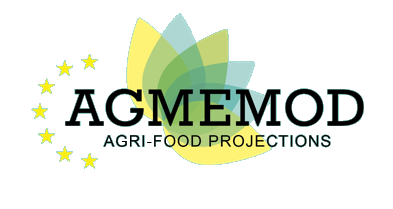AGMEMOD in brief
AGMEMOD is a system of mostly econometrically estimated partial equilibrium models for the agricultural, fishery and food sectors. The regional focus lies on the individually represented EU member states and their neighbors. AGMEMOD covers the most important agricultural activities of these countries in detail. The coverage can vary between the countries. The model captures, the interactions between the sectors, and the countries. AGMEMOD is primarily applied for baseline projections and also for analysis of agricultural market policies.
Type
Numerical simulation model
Typical application
- Long term market projections
- Analysis of policy changes
- EU common agricultural policy (CAP)
- EU fishery policy
- Biofuel policy
- Simulation of countries’ accession and exit of the EU
Important co-operations
AGMEMOD partnership (direction: Thünen Institute and WEcR) consisting of research institutes, university and other partners in the EU and beyond.
Special features
- Cooperation of EU member states, possible accession countries, EU neighbor countries and selected other countries
- Based on a harmonised template, the country models are adapted to national characteristics by the responsible partners
- Updated database with a long time series
Data base
Continues data updates; the data can cover 1973 to 2017 depending on availability.
Regions / Countries (EU)
The individual EU member states (Belgium and Luxemburg as one) and additional countries, e.g., Macedonia, Russia, Ukraine and Turkey.
Constant extensions of regions, current focus is the development of models for selected African countries.
Sectors
Vary depending on country .
Currently up to 20 agricultural sectors, 17 food sectors, 11 fish sectors.
Constant extensions of sectors, current focus is representing the bio economy.
Policy measures
- Intervention prices
- Coupled and decoupled direct payments
- Set-aside/ ecological focus areas
- Production quotas (abolishment)
- Fishing quotas
- Fisheries Support Estimate (FSE)
- Resource demand for biofuels
- Tariff rate quotas and tariffs
Extensions depending on research question, in the future, e.g., market relevant policy instruments of the CAP after 2020.
Trade
Imports and exports of the represented countries and net trade for the EU (no bilateral trade).
Endogenous variables
Policy variables (e.g., intervention prices, (coupled and decoupled direct payments, tariff rate quotas), factor endowments, GDP, population, exchange rates, inflation, technical coefficients (e.g., fat content).
Exogenous variables
Prices and quantities on national and international agricultural and food markets.
Software
GAMS (Simulation), Excel (Database), R (Estimation of equations), GTREE (Model code), GsePro (Interface)
Further information
Further persons in the Thünen AGMEMOD team
- Laura Angulo: Modelling of fish sector
- Martin Banse: Coordination
- Aida Araceli Gonzalez-Mellado: African countries
- Marlen Haß: Modelling of sweetener sector
- Verena Laquai, Max Zirngibl: Modelling of grain and oilseed markets







